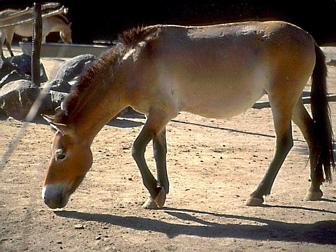
OVERVIEW
While the Przewalski's Horse (also known as the Mongolian Wild Horse) is probably the oldest surviving equid, it was only "discovered" in the last century. On an expedition in the mountains of the Western Gobi desert, Colonel Nicholai M. Przewalski found a herd of wild horses quite unlike any breed seen before. These horses were found to be the living link between the modern horse and its prehistoric ancestors which migrated to Asia from North America many thousands of years ago. These rugged little horses (12 to 14 hands high) lived in isolation in a harsh, demanding environment where only the heartiest survived. Most Przewalski's Horses have been killed by hunters. 200 now live in zoos around the world and about 40 still live in the wilds of Mongolia.
PHYSICAL DESCRIPTION
The Przewalski's Horse stands between 12 and 14 hands and appears in a variety of shades of dun, ranging from cream to red. The head is thick, the ears rather long and the nostrils are large. The bristled mane stands off the neck and is partly dark in color. The barrel is rather large. The legs are short with strong bone. Occasionally "zebra" stripes are found on the legs. A dorsal stripe runs the length of the back. The temperament of the Przewalski is quite wild, and they have not been successfully domesticated.
ORIGIN
The Przewalski's Horse is native to Mongolia in the Western Gobi desert. It is the oldest form of equid in existence and is most closely related to the prehistoric horse. Its existence has been documented in art since the Ice Age.
INTERESTING FACTS
The Przewalski's Horse was for many years threatened with extinction since it was preyed upon by man. Hunters would wait at the few desert watering holes available to the horses and would kill the horses coming to drink. There are perhaps only 40 or so Przewalski's Horses left in the wild. The government of the former Soviet Union intended to establish a preserve where these horses can again live in freedom and safety. The Przewalski's Horse is considered an endangered species.
INFLUENCES
1. Asiatic Wild Horse
2. Mongolian
For more information:
http://www.imh.org/imh/bw/prz.html
Foundation for the Preservation and Protection of the Przewalski's Horse Department of Animal and Dairy Science University of Georgia 322 Livestock-Poultry Bldg. Athens GA 30602-2771 Phone: (404) 542-0976 Fax: (404) 542-0399